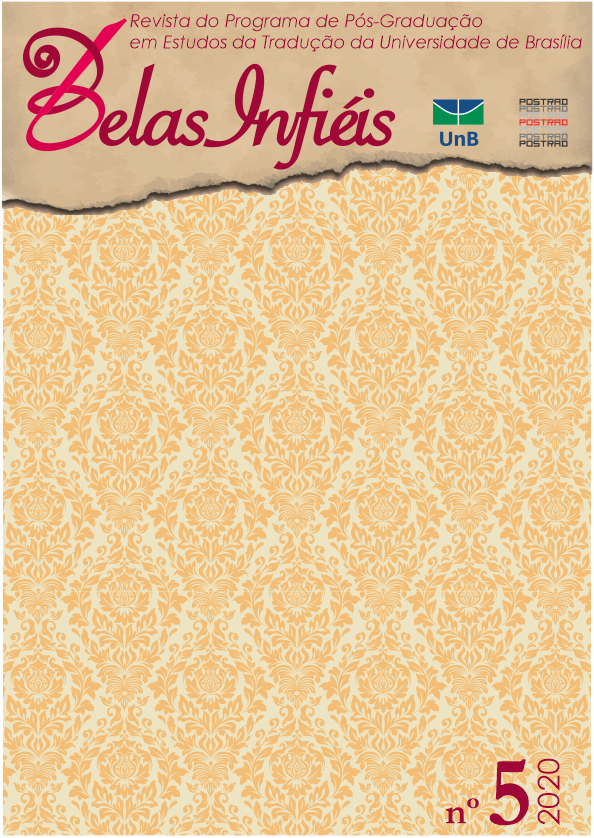A poética de Louise de Vilmorin: um desafio tradutório
DOI :
https://doi.org/10.26512/belasinfieis.v9.n5.2020.31536Mots-clés :
Louise de Vilmorin. L’Alphabet des aveux. Transcriação. Intraduzibilidade. Estudos da Tradução.Résumé
O presente artigo tem por objetivo discorrer sobre a obra poética de Louise de Vilmorin, escritora francesa do século XX, de reputada fama nos meios literários parisienses e com vasta publicação e incursões em diferentes gêneros literários, tendo escrito romances, novelas, contos, poemas etc., cuja obra permanece ainda hoje inédita no Brasil. Dada a extensão de sua produção poética, que conta com dezenove obras, o foco do artigo foi direcionado ao seu décimo livro, L’Alphabet des aveux, publicado em 1954, pela editora Gallimard, com ilustrações de Jean Hugo. Será questão a reflexão sobre os desafios tradutórios que envolvem a obra L’Alphabet des aveux, caracterizada por um complexo trabalho linguístico, em que identificamos a presença de palíndromos, versos (h)olorimes, caligramas, rébus, entre outros procedimentos reputados intraduzíveis. Para tanto, serão utilizadas obras de cunho biográfico, como Je suis née inconsolable: Louise de Vilmorin (2008), ou ainda Essai sur Louise de Vilmorin (1962), escrito por seu irmão, André de Vilmorin, para apresentar a trajetória profissional e pessoal da escritora. Ademais, no que no tange à análise da obra em questão por um viés tradutório, serão utilizados os textos de Haroldo de Campos sobre a Teoria da Transcriação que constam no livro organizado por Marcelo Tápia, intitulado Transcriação (2013), corrente teórica escolhida para refletir sobre as possibilidades tradutórias de sua obra, uma vez que permite pensar a relação entre original e tradução sob uma perspectiva não prescritiva, na qual o tradutor exerce função análoga ao autor com vistas a uma recriação paramórfica, bem como os textos do crítico e tradutor Henri Meschonnic, Critique du rythme (1982) e Poétique du traduire (1999), de modo a embasar teoricamente a discussão sobre os elementos melopeicos que estruturam os poemas de L’Alphabet des aveux e constituem um verdadeiro desafio tradutório aos que desejam apresentar tal obra a um novo público-leitor.
Téléchargements
Références
BOTHOREL, Jean. Louise ou la vie de Louise de Vilmorin. Paris: Grasset, 1993.
CAMPOS, Haroldo de. Transcriação. In: TÁPIA, Marcelo; NÓBREGA, Thelma Médici (Org.). Haroldo de Campos ”“ Transcriação. São Paulo: Perspectiva, 2013.
CATFORD, John C. Um teoria linguística da tradução: um ensaio de linguística aplicada. Tradução do Centro de Especialização de Tradutores de Inglês do Instituto de Letras da Pontifícia Universidade Católica de Campinas. São Paulo: Cultrix; Campinas: Pontifícia Universidade Católica de Campinas, 1980.
MAURIÈS, Patrick. Louise de Vilmorin, un album. Paris : Le Promeneur, 2002.
MESCHONNIC, Henri. Critique du rythme: anthropologie historique du langage. Lagrasse: Verdier, 1982.
MESCHONNIC, Henri. Poétique du traduire. Lagrasse: Verdier, 1999.
MILTON, John. Literary Translation Theory in Brazil. Meta. XLI, n.2, p. 196-207, 1996.
NIDA, Eugene. Toward a Science of translating. Leiden: E. J. Brill, 1964.
POUND, Ezra. ABC da literatura. Traduzido por Augusto de Campos e José Paulo Paes. São Paulo: Cultrix, 1970.
TÁPIA, Marcelo; NÓBREGA, Thelma Médici (Org.). Haroldo de Campos ”“ Transcriação. São Paulo: Perspectiva, 2013.
VILMORIN, André de. Essai sur Louise de Vilmorin. Vienne : Pierre Seghers, 1962.
VILMORIN, Louise de. L’Alphabet des aveux. Paris : Gallimard, 2004.
WAGENER, Françoise. Je suis née inconsolable : Louise de Vilmorin (1902-1969). Paris : Albin Michel, 2008.
Téléchargements
Publié-e
Comment citer
Numéro
Rubrique
Licence
(c) Tous droits réservés CC BY 2020

Cette œuvre est sous licence Creative Commons Attribution 4.0 International.
Copyright Statement
Given the public access to this journal, the texts are free to use but requires the recognition of the original authorship and initial publication in this journal to be properly stated.
The journal allows the use of works published for non-commercial purposes, including the right to submit the work to publicly accessible databases. Published contributions are the sole and exclusive responsibility of the author(s).
- When submitting papers to be evaluated by the Belas Infiéis journal, the author(s):
- Declare that the contents of the contributions are original and of their original creation, being entirely responsible for their content if there is an objection by third parties.
- Claim to be aware that they should not commit academic plagiarism.
- Declare that the manuscript has not been published, completely or partially, in Portuguese or another language. If it is a translation it should be submitted to the Translated Articles section.
- Declare that the manuscript is not being evaluated by other journals.
- Declare that the manuscript was not submitted to another journal simultaneously.
- Commit(s) to inform the journal of any kind of error or inaccuracy in their contribution (published, in evaluation or in editing) and to collaborate with the editors to make due corrections of the article (when in evaluation or editing) or erratum/retraction (after publication).
- Declare that there is no conflict of interest regarding the published work.
- Authorize its release if it is accepted for publication without any kind of monetary compensation.
- Agree to assign non-exclusive rights to publication to the magazine, remaining free to make their contribution available in other media as long as the publication of the first version in Belas Infiéis magazine is mentioned. They also authorize Belas Infiéis to assign their texts for reproduction in content indexers, virtual libraries and similar platforms.
- Maintain copyright and grant the journal the right of first publication, the work being licensed under theCreative Commons Attribution License.
- Is/Are allowed and encouraged to publish and distribute their work online after the editorial process, which may increase the impact and citation of the published work.
- Authorize the editorial team to make textual adjustments and to adapt the article to the publication rules, when necessary.



















